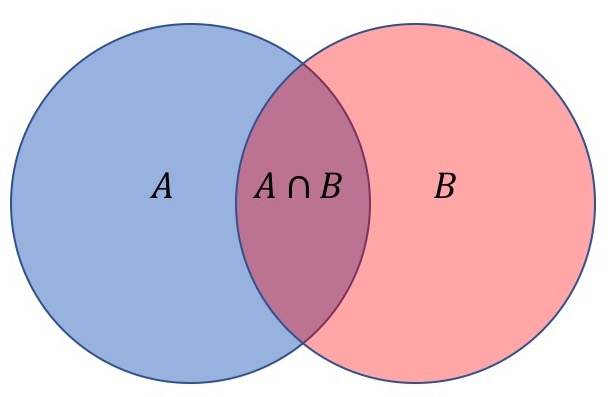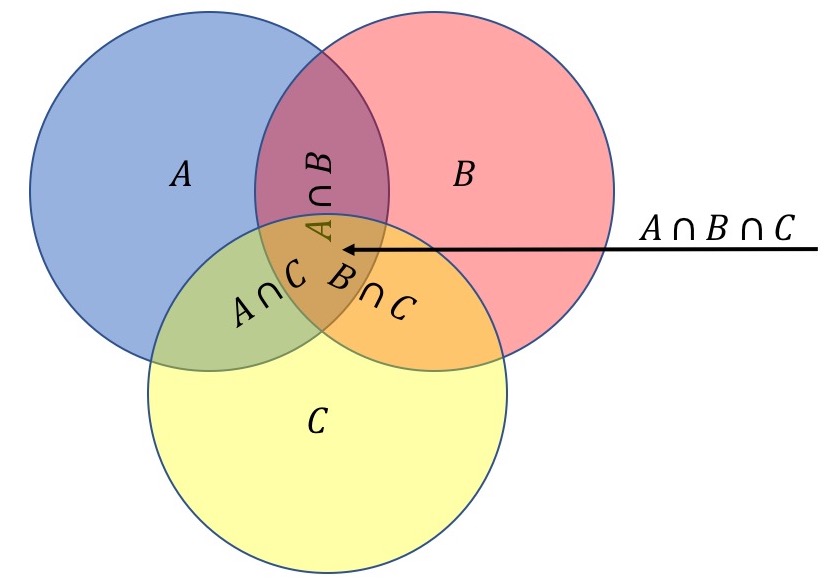Counting
In this post, it will cover the definition of sets and some examples, and shows usage in Python. This post is a summary of "Probability and Statistics in Data Science using Python", offered from UCSD DSE210x
- Set Size
- Disjoint Unions
- General Unions
- Cartesian Products
- n Sets
- Cartesian Powers
- Counting Variations
- Counting Trees
- Exercise 1
- Exercise 2
Set Size
Set Size
The number of elements in a set $S$ is called its size or cardinality, and denoted $\vert S \vert$ or $\# S$.
For example,
- Bits: $\vert\{0, 1\}\vert = 2$
- Coin: $\vert\{\text{heads, tails}\} \vert = 2$
- Die: $\vert\{1, 2, 3, 4, 5, 6\}\vert = 6$
- Digits: $\vert\{0, 1, \dots, 9\}\vert = 10$
- Letters: $\vert \{ a, \dots, z\} \vert = 26$
- Empty set: $\vert \emptyset \vert = 1$
- Integers: $\vert \mathbb{Z}\vert = \vert \mathbb{N} \vert = \vert \mathbb{P} \vert = \infty$ (Countably infinite $\aleph_0$)
- Reals: $\vert \mathbb{R} \vert = \infty$ (Uncountably infinite $\aleph$)
Integer Multiples
$$ {}_d (n] = \{1 \leq i \leq n : d / i \} $$
For example,
- ${}_3(8] = \{3, 6\} = \{1\cdot3, 2\cdot3\}$
- ${}_3(9] = \{3, 6, 9\} = \{1\cdot3, 2\cdot3, 3\cdot3\}$
$$ \vert {}_d (n] \vert = \lfloor n/d \rfloor$$
For example,
- $\vert {}_3(8] \vert = \lfloor 8/3 \rfloor = 2$
- $\vert {}_3(9] \vert = \lfloor 9/3 \rfloor = 3$
print(len({-1, 1}))
print(sum({-1, 1}))
print(min({-1, 1}))
print(max({-1, 1}))
A = {1, 2, 3}
print(sum(A))
total = 0
for i in A:
total += i
print(total)
Disjoint Unions
Disjoint Unions
A union of disjoint sets is called a disjoint union.
For example,
- $\{0\} \cup \{1\} = \{0, 1\}$
For disjoint sets, the size of the union is the sum of the sizes.
$$ \vert A \cup B \vert = \vert A \vert + \vert B \vert $$
General Unions
General Unions
- Disjoint $A$ and $B$: $\vert A \cup B \vert = \vert A \vert + \vert B \vert$
- Size of union = sum of sizes
- In general: $\vert A \cup B \vert \neq \vert A \vert + \vert B \vert$
- $\vert \{a\} \cup \{a\} \vert = \vert \{a\} \vert = 1$
- $\vert \{ a \} \vert + \vert \{ a \} \vert = 2$
$$ \vert A \cup B \vert = \vert A \vert + \vert B \vert - \vert A \cap B \vert $$
This is Principle of Inclusion-Exclusion(or PIE for short)
Multiple sets
- Two sets
$$ \vert A \cup B \vert = \vert A \vert + \vert B \vert - \vert A \cap B \vert $$
- Three sets
- n sets
$$ \Big \vert \cup_{i=1}^n A_i \Big \vert = \sum_{i \leq i \leq n} \vert A_i \vert - \sum_{1 \leq i < j \leq n} \vert A_i \cap A_j \vert + \cdots + (-1)^{n-1} \Big \vert \cap_{i=1}^n A_i \Big \vert $$
Sanity checks
- $A$, $B$ disjoint
$$ \vert A \cup B \vert = \vert A \vert + \vert B \vert - \vert A \cap B \vert = \vert A \vert + \vert B \vert $$
- Equal sets
$$ \vert A \cup A \vert = \vert A \vert + \vert A \vert - \vert A \cap A \vert = \vert A \vert $$
- nested/disjoint
$$ \max \{ \vert A \vert, \vert B \vert \} \leq \vert A \cup B \vert \leq \vert A \vert + \vert B \vert $$
Cartesian Products
Cartesian Products
If $\vert \{a, b\} \vert = 2$ and $\vert \{1, 2, 3\} = 3$, then
$$ \{a, b\} \times \{1, 2, 3\} = \begin{Bmatrix} (a, 1) & (a, 2) & (a, 3) \\ (b, 1) & (b, 2) & (b, 3) \end{Bmatrix} $$
And,
$$ \vert \{a, b\} \times \{1, 2, 3\} \vert = 2 \times 3 = 6 $$
In general, the size of a Cartesian Product is the product of the set sizes.
$$ \vert A \times B \vert = \vert A \vert \times \vert B \vert $$
Three Sets
If we have two sets, ($A \times B \quad \{(a, b): a \in A, b \in B \}$), its shape has rectangle, And set size is $\vert A \times B \vert = \vert A \vert \times \vert B \vert$
If we have three sets, ($A \times B \times C \quad \{(a, b, c): a \in A, b \in B c \in C\}$), then its shape has cuboid, and number of element will be
$$ \vert A \times B \times C \vert = \vert A \vert \times \vert B \vert \times \vert C \vert $$
Cartesian Powers
Cartesian Powers of a Set
Cartesian product of a set with ifself is a Cartesian Power
- Cartesian Square: $A^2 = A \times A$
- $n$-th Cartesian Power: $A^n \stackrel{\text{def}}{=} \underbrace{A \times A \times \dots A}_n $
- $\vert A^n \vert = \vert A \times A \times \dots \times A \vert = \vert A \vert \times \vert A \vert \times \dots \times \vert A \vert $
Subsets
The power set of $S$, denoted $\mathbb{P}(S)$ is the collection of all subsets of $S$,
$$ \mathbb{P}(\{a, b\}) = \Big\{ \{ \}, \{a\}, \{b\}, \{a,b\}\Big\} $$
By the 1-1 correspondence betwen $\mathbb{P}(S)$ and $\{0,1\}^{\vert S \vert}$,
$$ \vert \mathbb{P}(S) \vert = \vert \{0, 1\}^{\vert S \vert} \vert = 2^{\vert S \vert} $$
The size of the power set is the power of the set size.
Functions
A function from $A$ to $B$ maps every element $a \in A$ to an element $f(a) \in B$
- Define a function $f$: specify $f(a)$ for every $a \in A$
- $f$ from $\{1, 2, 3\}$ to $\{p, u\}$: $f(1)=p, f(2)=u, f(3)=p$
- $f: 3-\text{tuple}(f(1), f(2), f(3)): (p, u, p)$
- $\{\text{functions from } \{1, 2, 3\} \text{ to } \{p, u\}: \{p, u\} \times \{p, u\} \times \{p, u\}$
- size of functions from $\{1, 2, 3\}$ to $\{p, u\}$ = $2^3 = \vert \{p, u\} \vert^{\vert \{1, 2, 3\} \vert}$
- $\{\text{functions from } A \text{ to } B \} \quad \underbrace{B \times B \times \dots \times B}_{\vert A \vert} = B^{\vert A \vert}$
- Size of functions from $A$ to $B$: $\vert B^{\vert A \vert} \vert = \vert B \vert^{\vert A \vert}$
import itertools
print(set(itertools.product({2, 5, 9}, repeat=2)))
- Exponent
3 ** 2
PINs Containing Zero
Consider 4 digit PINs with containing zero
- $D = \{0, 1, \dots, 9\}$
- $Z = \{0\}, \bar{Z} = \{1, 2, \dots, 9\}$
Note: $\bar{Z} = Z^c$: set of non-zero digits
- $x^n \triangleq x_1, \dots, x_n$ - ($n$-digit sequence)
$\qquad \rightarrow \exists Z = \{ x^n \in D^n : \exists i x_i \in Z\} $: {$n$-digit PINs containing 0}
- $\vert \exists Z \vert = ?$
2-Digit case - Complement Rule
$$ \exists Z = \{x_1 x_2 : \exists i \quad x_i = 0\} $$
-
$\omega = D^2$
-
$\bar{\exists Z} = \bar{\{x_1 x_2: \exists i \quad x_i = 0 \}} = \{x_1 x_2: \forall i \quad x_i \neq 0\} = \bar{Z} \times \bar{Z}$
- $ \vert \bar{ \exists Z} \vert = \vert \bar{Z} \times \bar{Z} \vert = \vert \bar{Z} \vert^2 $
n-Digit case - Inclusion-Exclusion
$$ \exists Z = \{ x^n : \exists i \quad x_i = 0 \} $$
- $Z_i = \{x^n: x_i = 0\}$
- $\exists Z = Z_1 \cup \dots \cup Z_n$
- $\vert \exists Z \vert = \vert Z_1 \vert + \vert Z_2 \vert + \dots + \vert Z_n \vert - \vert Z_1 \cap Z_2 \vert - \vert Z_1 \cap Z_3 \vert - \dots - \vert Z_{n-1} \cap Z_n \vert \\ + (-1)^{n-1} \vert Z_1 \cap Z_2 \cap \dots \cap Z_n \vert$
n-Digit case - Complement Rule
$$ \bar{\exists Z} = \bar{\{x^n \vert \exists i \quad x_i \in Z\}} = \{x^n \vert \forall i \quad x_i \not \in Z \} = (\bar{Z})^n \triangleq \forall \bar{Z} $$
- $\vert \forall \bar{Z} \vert = \vert \bar{Z} \vert^n = 9^n$
- $\exists Z = D^n - \forall \bar{Z} $
- $\vert \exists Z \vert = \vert D^n \vert - \vert \forall \bar{Z} \vert = 10^n - 9^n$
Exercise 1
Exercise 1.1

$$|A\cup B|=|A|+|B|-|A\cap B|.$$
Write the following functions to determine $|A\cup B|$ in two different ways.
A function union that determines first $A\cup B$ and then evaluates the union's size. Output the ordered pair $(A\cup B, |A\cup B|)$.
* **Sample run** *
A = {1, 2, 3}
B = {3, -6, 2, 0}
print union(A, B)
* **Expected Output** *
({-6, 0, 1, 2, 3}, 5)def union(A, B):
# inputs: A and B are of type 'set'
# output: a tuple of the type (set, set_length)
union_set = A.union(B)
union_size = len(union_set)
return (union_set, union_size)
A = {1,4,-3, "bob"}
B = {2,1,-3,"jill"}
assert union(A,B) == ({-3, 1, 2, 4, 'bob', 'jill'}, 6)
Exercise 1.2
A function inclusion_exclusion that first deterimines $|A|$, $|B|$, $A\cap B$, and $|A\cap B|$, and then uses the inclusion-exclusion formula to determine $|A\cup B|$. Output the tuple $(|A|, |B|, |A\cap B|, |A\cup B|)$.

A = {1, 2, 3}
B = {3, -6, 2, 0}
print inclusion_exclusion(A, B)
print "notice: 3 + 4 - 2 == 5"
* **Expected Output:** *
(3, 4, 2, 5)
notice: 3 + 4 - 2 == 5def inclusion_exclusion(A, B):
# inputs: A and B are of type 'set'
# output: a tuple of four integers
union_set = A.union(B)
intersect_set = A.intersection(B)
return (len(A), len(B), len(intersect_set), len(union_set))
A = {1, 2, 3, 4, 5}
B = {0, 2, -6, 5, 8, 9}
assert inclusion_exclusion(A, B) == (5, 6, 2, 9)
Exercise 2.1
Write function union3 that first determines $A\cup B\cup C$ and then evaluates the size of this union. Output the tuple $(A\cup B\cup C, |A\cup B\cup C|)$.
* **Sample run:** *
A = {1, 2, 3, 4, 5}
B = {0, 2, -6, 5, 8, 9}
C = {2, 10}
union3(A, B, C)
* **Expected Output:** *
({-6, 0, 1, 2, 3, 4, 5, 8, 9, 10}, 10)def union3(A, B, C):
# inputs: A, B and C are of type 'set'
# output: a tuple of the type (set, set_length)
union_set = A.union(B).union(C)
return (union_set, len(union_set))
A = {1, 2, 4, 5, 10}
B = {5, 2, -6, 5, 8, 9}
C = {2, 10, 13}
assert union3(A,B,C) == ({-6, 1, 2, 4, 5, 8, 9, 10, 13}, 9)
Exercise 2.2
A function inclusion_exclusion3 that first deterimines the sizes of $A$, $B$, $C$ and their mutual intersections, and then uses the inclusion-exclusion principle to determine the size of the union. Output the tuple $(|A\cap B\cap C|, |A\cup B\cup C|)$. Note that for brevity we are asking you to output the intermediate answer just for $A\cap B\cap C$, but you need to calculate all.
* **Sample run:** *
A = {1, 2, 3, 4, 5}
B = {0, 2, -6, 5, 8, 9}
C = {2, 10}
print inclusion_exclusion3(A, B, C)
* **Expected Output:** *
(1, 10)def inclusion_exclusion3(A, B, C):
# inputs: A, B and C are of type 'set'
# output: a tuple of two integers
intersect_set = A.intersection(B).intersection(C)
union_set = A.union(B).union(C)
return (len(intersect_set), len(union_set))
A = {1, 2, 4, 5, 10}
B = {5, 2, -6, 5, 8, 9, 10}
C = {2, 10, 13}
assert inclusion_exclusion3(A,B,C) == (2, 9)